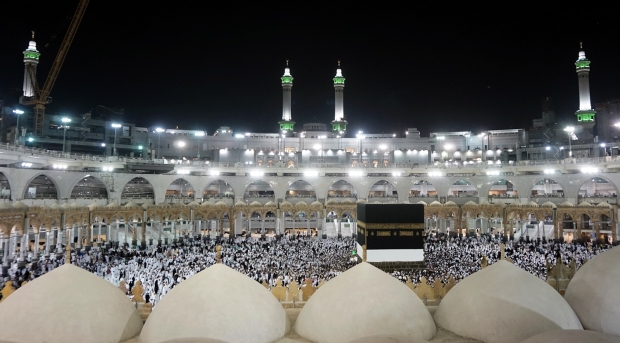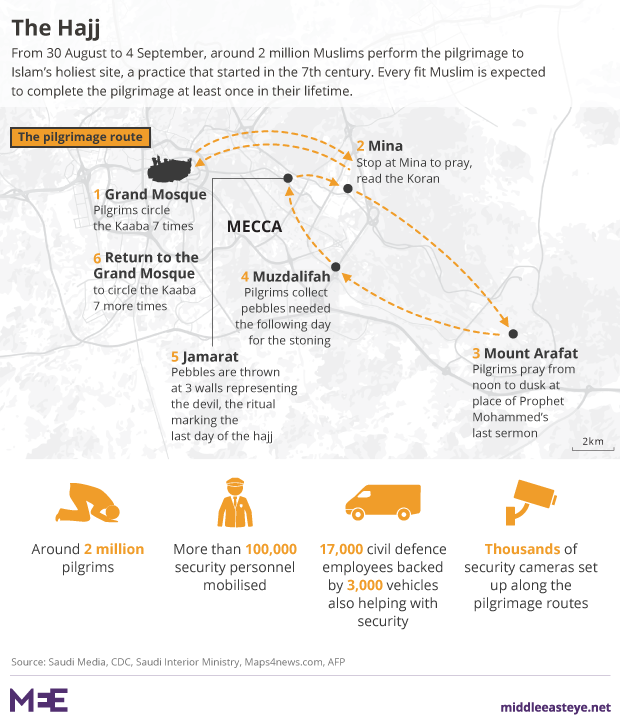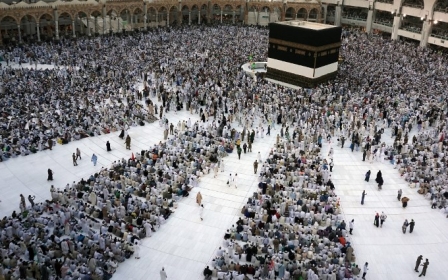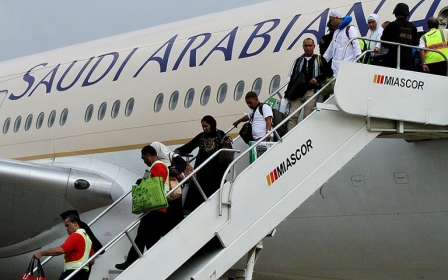More than 2 million Muslims begin Hajj spiritual journey

More than two million Muslims from around the world began the Hajj pilgrimage at Islam's holiest sites on Wednesday, a religious duty and a multi-stage spiritual journey.
This year, pilgrims from Iran are returning to Mecca in Saudi Arabia after a hiatus amid a diplomatic spat between the regional rivals and a deadly stampede in 2015.
It also comes with the Gulf mired in a political crisis that has caused thousands of faithful who would usually make the journey from neighbouring Qatar to stay away.
On the esplanade of Mecca's Grand Mosque, the excitement was palpable as crowds from around the world gathered for a pilgrimage that all able Muslims are required to perform at least once in their lives.
Tidjani Traore, a public service consultant from Benin, said he was on his 22nd pilgrimage at the age of 53.
"Every time, there are new emotions," he said. "There are new innovations for organising and hosting the pilgrims. Now, for example, the tents are air-conditioned."
Wearing the simple garb of the pilgrim, the faithful waited at dawn with their suitcases for buses to take them 5km east to Mina.
There, hundreds of thousands were gathering before they will set off on Thursday at dawn to climb Mount Arafat, the pinnacle of the Hajj.
In the midst of a hot desert breeze, the first arrivals prepared to spend the night in tents on the plain below Mount Arafat.
"I will spend the evening in prayer before we climb up the mountain for the dawn prayer," said a 72-year-old Tunisian woman, stretched out on a mattress.
Earlier in Mecca, the pilgrims performed a ritual walk known as the tawaf seven times around the Kaaba, a black masonry cube wrapped in a heavy silk cloth embroidered in gold with Koranic verses at the centre of Mecca's Grand Mosque.
The shrine is the point towards which Muslims around the world pray daily.
"I still have to finish the tawaf!" said a breathless Nour, 30, from Saudi Arabia as she rushed past without stopping.
Sitting on a folding chair in the middle of the esplanade, Risvana cradled her six-month-old baby accompanying her on the pilgrimage.
"I've planned everything for him," said the young mother, pointing to a bottle of water in her bag.
Saudi authorities have mobilised vast resources, including more than 100,000 security personnel, to avoid a repeat of the stampede in 2015 in which nearly 2,300 people were killed.
Iran alone reported 464 deaths - the highest toll among foreigners.
Riyadh and Tehran cut ties months later, after the execution of a Shia cleric in Saudi Arabia sparked attacks on Saudi diplomatic missions in Iran.
Iranian pilgrims were absent from last year's Hajj for the first time in decades after the regional rivals failed to agree on security and logistics.
This year's pilgrimage comes amid the diplomatic crisis between a Saudi-led bloc of Arab countries and Qatar, accused of supporting militant groups and being too close to Tehran.
A blockade imposed on Qatar since 5 June has seen sea and air links closed, preventing many Qataris from making the Hajj.
Years of anticipation
Although Saudi Arabia relaxed entry restrictions across its land border with the emirate two weeks before the Hajj, Qatar said only a few dozen of its nationals were able to join the pilgrimage.
This year, the colossal religious gathering comes with the Islamic State (IS) group under growing military pressure, having lost swathes of territory it controlled in Iraq and Syria.
For the Hajj, one of the world's biggest annual gatherings, tens of thousands of air-conditioned tents have been set up in Mina to house pilgrims, and more than 700 Saudi cooks recruited to feed the faithful.
On the esplanade of the Grand Mosque, authorities placed misting fans to take the edge off the intense heat.
On the eve of the first rites of the pilgrimage, the walkways were thronged with people and the smell of musk wafted through the air.
A few paces from the Kaaba, Egyptian pilgrim Fathiya Taha could not hide her joy.
At 67, she was the oldest in her group. She sat in a wheelchair in Islam's most holy spot.
"I've been looking forward to this pilgrimage for four years," she said.
Saudi Arabia's immigration department said women this year accounted for 46 percent of the foreign arrivals for the Hajj.
Religious tourism is part of the oil-rich country's "Vision 2030" plan to boost the economy in an era of low oil prices.
Middle East Eye propose une couverture et une analyse indépendantes et incomparables du Moyen-Orient, de l’Afrique du Nord et d’autres régions du monde. Pour en savoir plus sur la reprise de ce contenu et les frais qui s’appliquent, veuillez remplir ce formulaire [en anglais]. Pour en savoir plus sur MEE, cliquez ici [en anglais].







